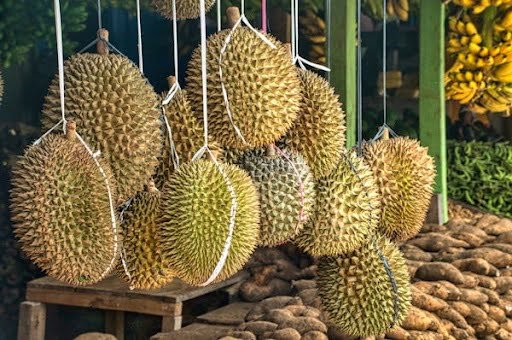What makes Durians unique?
Durians stand out due to their distinctive, strong odor and spiky exterior. Despite the smell, the creamy flesh inside offers an unparalleled taste experience that combines sweetness with savory undertones, making it a highly prized delicacy in various Southeast Asian cultures.
Importance of Durians to the culture of Singapore.
Durians hold significant cultural value in Singapore, symbolizing local pride and tradition. Known as the “king of fruits,” they are celebrated in festivals and cuisine, fostering community connections while representing a unique aspect of the nation’s culinary heritage. From street markets to gourmet restaurants, durians in singapore are savored and revered, highlighting the nation’s appreciation for bold flavors and cultural preservation.
History and Popular Beliefs about Durians in Singapore
The arrival and cultivation of Durians in Singapore.
The introduction and growth of Durian farming in Singapore have become notable agricultural developments, with the tropical climate providing optimal conditions. Today, Durians are celebrated for their unique flavor, becoming a sought-after delicacy among locals and tourists alike.
Myths and legends about Durians.
Durians, often dubbed the “king of fruits,” are surrounded by myths and legends. Some tales speak of their aphrodisiac properties, while others warn about mixing them with alcohol. These stories highlight the fruit’s unique status and cultural significance in various societies.
Understanding Different Varieties of Durian in Singapore
Description of main Durian varieties available in Singapore (e.g., Mao Shan Wang, D24).
Singapore offers an array of durian varieties such as Mao Shan Wang and D24. Each type boasts unique flavors; Mao Shan Wang is creamy with a bittersweet taste, while D24 is known for its rich, custardy texture and mildly sweet flavor.
Unique characteristics of each variety regarding taste, aroma, and texture.
Each variety boasts distinct traits in taste, aroma, and texture. Their flavors range from sweet to tangy; scents vary from subtle to pungent; textures can be smooth, creamy, or crunchy. These unique combinations create diverse culinary experiences for every palate.
Durian Season: When to enjoy Durians in Singapore
Explanation of when Durian season happens, and why.
Durian season typically occurs between June and August, driven by the tropical climate’s monsoon patterns. The increased rainfall during this period facilitates the fruit’s growth, resulting in optimal harvest conditions for this unique, popular fruit renowned across Southeast Asia.
How weather conditions affect Durian production and quality.
Weather conditions play a crucial role in durian production and quality, influencing factors such as fruit size, taste, and yield. Fluctuations in temperature, rainfall, and humidity can either enhance or diminish the overall growth and nutritional value of durians.
How to Select and Buy Quality Durians in Singapore
Essential factors in identifying a fresh and quality durian.
Key indicators of a fresh, high-quality durian include its distinct aroma, firm yet slightly yielding texture upon gentle pressure, well-formed husks without damage or mold, and vibrant green stem. The fruit should also sound hollow when tapped for ideal ripeness.
Tips on how to bargain and buy durians in local markets.
To effectively negotiate and purchase durians at local markets, check the fruit’s odor and spikes for ripeness. Engage in friendly conversation with vendors to build rapport, ask for price comparisons among stalls, buy in bulk for discounts, and don’t be afraid to walk away.
Popular Durian Dishes and Delicacies in Singapore
Exploring the use of Durian in different Singaporean cuisines.
Investigating durian’s role in Singaporean cuisine reveals unique applications across dishes. This distinctive fruit enriches traditional flavors, appearing in desserts, savory meals, and innovative recipes, showcasing the culinary creativity and adaptability of chefs within Singapore’s diverse food culture.
Sharing recipes of popular local Durian dishes.
Exchanging recipes for beloved local durian dishes fosters culinary creativity and cultural appreciation. Enthusiasts share innovative uses of the pungent fruit, enriching diverse palates with unique flavors while preserving traditional cooking techniques that celebrate this iconic Southeast Asian ingredient.
Health Benefits: The Nutritional Importance of Eating Durians
Discussing the nutritional contents of Durians.
Analyzing durian’s nutritional profile reveals its richness in vitamins such as C and B-complex, along with minerals like potassium and manganese. Additionally, it provides a significant amount of dietary fiber and healthy fats, while being relatively moderate in carbohydrates and protein.
Exploring the health benefits of eating Durian.
Diving into the advantages of consuming durian reveals numerous health benefits, from its rich nutrient profile to potential heart and digestion improvements. This tropical fruit’s antioxidants and vitamins can boost overall well-being when incorporated sensibly into a balanced diet.
Etiquette and Rules Surrounding Eating Durians in Singapore
Mention of government rules regarding Durian consumption, the Durian ban in some public places.
Certain government regulations address Durian consumption, prohibiting the fruit in specific public spaces due to its strong odor. These rules aim to maintain public comfort by restricting Durian presence in areas like hotels and public transportation systems where its smell might disturb others.
Social etiquette when eating and sharing Durian in Singapore.
When enjoying durian in Singapore, it’s crucial to be mindful of its strong aroma and others’ preferences. Opt for designated areas and avoid common spaces. Sharing is appreciated, but inquire before offering. Dispose of leftovers properly to respect public cleanliness.



